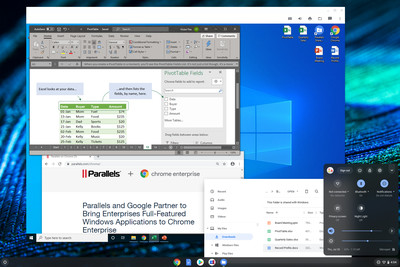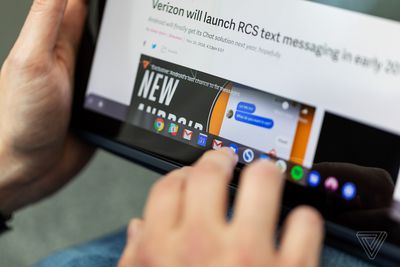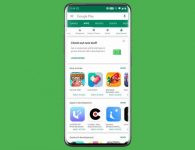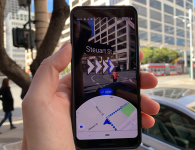

Chrome OS will run Android and Windows apps side by side
Google revealed earlier this year that it’s planning to support Windows applications on Chromebooks thanks to a partnership with Parallels. It’s a collaboration that will see a full version of Windows boot inside Chrome OS, providing businesses the option to run existing desktop apps on Google’s range of lightweight Chromebook devices. In an exclusive interview with The Verge, Google is now detailing how and why Windows apps are arriving on Chrome OS.
Google wants to give you access to Windows apps when you really need them, as a hop in and out experience. “The analogy I give is that yes, the world is all state of the art and Dolby Atmos home theaters, but every once in a while you do have that old wedding video on a VHS that you need to get to,” says Cyrus Mistry, group product manager for Chrome OS. “We want to make sure you have that option [for Windows apps] as well… so that every once in a while you’ll be able to get that when you need it, but we don’t want that to be the world you’re living in.”
Google is positioning this new Windows app support in Chrome OS as a big incentive for enterprises considering switching employees over to Chromebooks. Resellers will be able to bundle Parallels Desktop with Chromebook Enterprise devices, and IT administrators will be able to easily enable access to Parallels for Chromebooks that are enrolled with the Chrome Enterprise Upgrade.

At first, Parallels Desktop will boot a full copy of Windows, allowing Microsoft’s operating system to sit side by side with Chrome OS and Android apps. Chrome OS will even redirect certain Windows file types directly to the Parallels instance to make things a little more seamless for users.
“In the future we’ll have other types of things where you don’t even have to run the whole Windows desktop, you’ll just run the app you need,” explains Mistry. “We are trying to make it as seamless as possible.” This will likely involve Parallels’ Coherence feature, which is a mode that currently allows Mac users to run Windows apps as if they were native Mac applications.
“We worked with Parallels because they really have done this before. They understand the concept of running an entirely separate OS within another OS. They’ve done it with Mac and they’ve done it with Linux,” says Mistry. “We also have experience doing that, because of Android, so we already knew what we had to do on our side, but we wanted someone who knew how to do it with Windows.”
Google and Parallels aren’t discussing pricing or exact launch dates yet, but there will be a cost involved for Parallels itself and enterprises will obviously need Windows licenses to run these apps. Google is launching an interest page today, with plans to make Parallels Desktop available to businesses later this year. Businesses will also need relatively modern Chromebooks to run Parallels Desktop. Google isn’t releasing exact minimum specifications just yet, but Mistry says Parallels will be limited to what the company refers to as “for power usage” Chromebooks. These typically ship with Intel’s Core i5 or Core i7 processors, and 8GB of RAM for devices with a fan or 16GB of RAM for fanless models.

Photo by Vjeran Pavic / The Verge
While Google has partnered with Parallels to bring Windows apps to Chrome OS, the company had been investigating dual-boot options for years before ending work on the project last year. “We absolutely looked at dual boot,” admits Mistry. “There are pros and cons to both options, but where we landed is that security is absolutely paramount to Chrome OS.”
Mistry says Google “didn’t want to sacrifice” the security of Chromebook BIOS, firmware, and the overall boot process. Chromebooks perform a verified boot process to check the OS is secure, and there’s even a second, mirrored version of the OS that Google can flip to if it finds anything wrong.
Security has always been a big focus for Chrome OS, and the simplicity of management has appealed in education, where US schools have flocked toward Chromebooks. Google is now hoping that the support for Windows apps will allow it to attract a new audience, particularly as Google says Chromebook commercial sales are up 155 percent year over year.
“This should provide companies with the best of both worlds. It’s exactly what they’ve been wanting, a really easy to manage, secure endpoint,” says Mistry. “At the same point they need that escape valve. You want to be able to give your employees the most secure and easy to use thing that you can, but at the same time they need to be able to do everything.”
Google’s strategy here is to try to move businesses to a more simplified and secure operating system by default and push enterprises even further toward cloud and web app adoption. “We’re on the right side of the trend,” claims Mistry. “Nobody is dusting off their .NET and C# books, they’re building for the web.”

Google hasn’t always been successful with its push for web apps, though. Earlier this year, Google scrapped Chrome apps, web-based apps that you could install in Chrome that looked and functioned like an app you’d launch from your desktop. Google is now turning its attention to Progressive Web Apps (PWAs) instead.
Google isn’t alone in its web-based ambitions, either. There are signs that Microsoft is also preparing for a world where Windows apps live in the cloud, ready to be legacy apps for businesses that rely on them. Businesses have been streaming Windows apps remotely to iOS and Android for years, but Microsoft has a renewed effort to focus on Windows Virtual Desktops as part of the company’s plan to combine desktop and Universal Windows Platform (UWP) apps under Project Reunion.
Microsoft is also working on Windows 10X, which increasingly looks like more of a Chrome OS competitor that will run traditional desktop apps in a sandbox and focus on web apps and new UWP apps. While Windows 10X was supposed to launch on dual-screen devices, Microsoft has now reprioritized the OS for laptops. Windows 10X is now expected to arrive in 2021.
Google, naturally, wants to move everyone away from Windows and for the OS to be used less by businesses. “If you’re the type of person who is 80 or 90 percent in the browser, which by the way is starting to be almost every worker out there, then this is what you want them to be doing,” says Mistry. “You want them in a secure browser endpoint, but then escaping out to do a Windows thing and coming back.”
Both Google and Microsoft have similar security goals that will shape the future of Windows. Google is planning to leverage its Chrome OS security benefits and the unique ability to have a desktop-class browser, an entire mobile Android application ecosystem, and now access to Windows apps. Microsoft is obviously trying to simplify Windows with Windows 10X, and the company can leverage its native support for Windows apps more than any other operating system.
Google still has a long way to go with Chrome OS to address some productivity basics. Critics claim Chrome OS has “stalled out” with a vision that’s too restrictive. Parallels Desktop is an example of Google’s goal to address a gap in Chrome OS, and if the search giant can seamlessly blend Windows apps into Chrome OS in the future, then it definitely makes Chromebooks a lot more attractive to businesses that depend on a legacy line of business apps. It’s a big if given the underwhelming state of Android mobile apps on Chrome OS, but Windows desktop apps might just have a better chance with help from Parallels.
read more at https://www.theverge.com/ by Tom Warren
Tech







